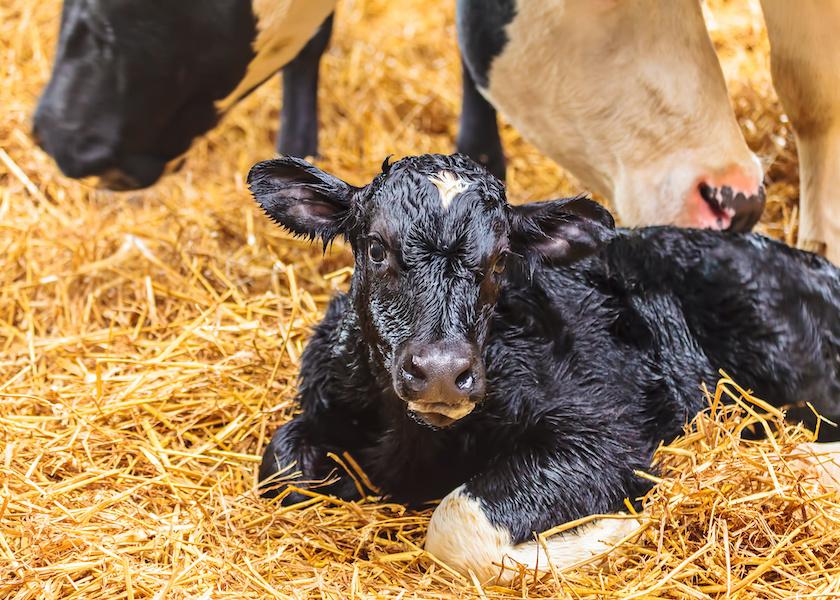How to Mimic the Perks of Transition Milk

In nature, calves automatically receive transition milk from their dams as colostrum production gradually shifts to whole milk in the first week of lactation.
But as rearing practices for dairy calves changed and dairies became larger, transition milk mostly left the picture altogether, as many calves were switched immediately from first-day colostrum to whole milk or milk replacer.
Then, in recent years, researchers began revisiting the merits of transition milk, according to calf nutrition expert David Wood with Animix LLC.
Wood said multiple studies proved that calves receiving transition milk had significantly improved digestive development; lower incidence of diarrhea; reduced need for antibiotic treatments; and improved average daily gain (ADG), compared to calves that were switched directly from colostrum to the regular milk or milk replacer diet.
But this knowledge can be difficult to translate into practice for many of today’s calf-raising enterprises. Harvesting and feeding transition milk can require time-consuming and labor-intensive processes at a time when the dairy labor market is tighter than ever.
Managing transition milk on-farm can present risks for transmitting disease if it is not handled and stored properly. Pasteurization errors also can damage bioactive components like IgG. Plus, many calves are moved in their first week of life to calf ranches or other off-site rearing facilities that are not in close proximity to the dams’ transition milk supply.
The solution? Wood said the ongoing dose of beneficial immunoglobulin G (IgG) that transition milk provides can be replicated using high-quality, spray-dried bovine plasma (SDBP) as a supplement to whole milk or a protein source in calf milk replacer formulations.
In a paper recently published in the journal Veterinary Clinics of North America: Food Animal Practice, Wood cited laboratory evaluation of a commercial SDBP product that revealed an average contents of 22.2 g IgG/100 grams of powder. He also shared results of several studies that showed SDBP supplementation resulting in benefits similar to those of transition-milk feeding, including:
- A 75g/day dose of SDBP prevented clinical signs of disease when calves were challenged with orally administered, virulent strains of E. col. Control calves that received no SDBP supplement experienced severe diarrhea, fever, loss of appetite, and 100% mortality. An intermediate group that received only 30g/day of SDBP demonstrated some morbidity and mortality, both neither were as severe as in the control group.
- Calves receiving a relatively low (15 g/day) inclusion rate of SDBP compared to non-treated controls -- all of which were challenged at 3 days of age with an oral dose of E. coli -- showed superior results. The SDBP-supplemented calves had better attitude scores, hydration scores, and 21-day bodyweight gains. In addition to enduring the disease challenge more successfully than their untreated counterparts, their performance equaled that of a third group that was treated instead with 800:400 g/ton of neomycin/oxytetracycline.
- Calves supplemented with spray-dried bovine serum (SDBP with the fibrinogen fraction removed) were fed a relatively high dose of 32 g bovine serum-based IgG 24 hours after an oral challenge dose of a virulent coronavirus. Compared to non-treated controls, the supplemented calves showed increased packed cell volume and a 29.5% improvement in feed intake.
- Eight-day-old calves fed whey-based milk replacer and either 57 g/day of spray-dried bovine serum, or soy protein isolate, were orally challenged with Cryptosporidium parvum. Compared to the soy group, the bovine serum group showed a 33% reduction in diarrhea volume, and a nearly four-fold decrease in oocyte shedding at the time of peak illness. All study animals were euthanized at 9 days post-infection, with necropsy results showing a 15% improvement in both intestinal villus surface area and crypt depth for the serum-supplemented calves versus the soy group.
Wood added that replacing some whey protein concentrate with plasma at researched rates in formulas is typically cost-neutral, so the benefits of creating transition milk using plasma can be achieved with no added cash outlay. He also shared additional details on the effects of using SDBP to produce similar benefits to transition milk in video 1and video 2.
“We’re learning more about the intricacies of calf nutrition all the time,” shared Wood. “In the case of SDBP, we have learned that we can supplement milk and milk replacer formulas with a consistent, convenient, research-proven, antibiotic-free option that supports calves in a comparable way to transition milk.”







